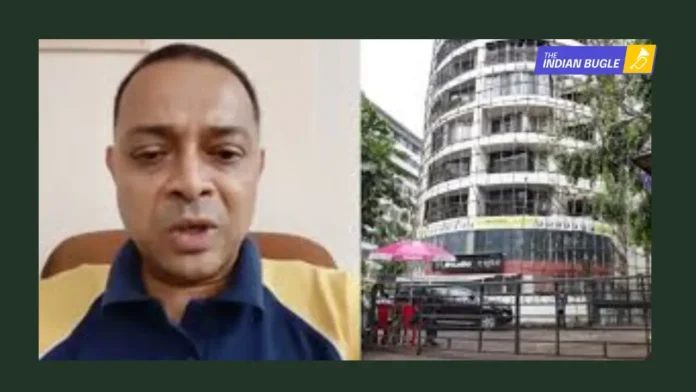Rohit Arya was a Mumbai-based filmmaker who became the center of national attention following a shocking incident at a film studio in Powai, Mumbai, on October 30, 2025. Reports describe him as an educated and creative individual with a background in filmmaking and teaching, known among his circle for being passionate about his work.
However, what unfolded that day took everyone by surprise, revealing how sudden emotional breakdowns and stress can push a person to extreme behavior.
What Happened in Powai?
On October 30, 2025, Rohit Arya entered a studio in Powai, where a children’s workshop was taking place. During the session, he reportedly held 17 children and 2 adults hostage inside the building.
Police were called immediately after people nearby heard shouting and panic. A tense situation followed, lasting several hours. Law enforcement surrounded the area, and after negotiations failed, an operation was carried out to rescue the children.
During the rescue attempt, Rohit Arya was shot by police when he allegedly tried to harm the hostages. He was taken to the hospital but later succumbed to his injuries. Thankfully, all children and adults were rescued safely.
Why Is the Incident Making a Buzz?
The case has sparked widespread discussion for several reasons:
1. Involvement of Children
Incidents involving kids naturally cause public concern. Parents across the country were shaken by the thought that a routine workshop could turn dangerous so suddenly.
2. Shocking Behavior from a Known Professional
Rohit Arya was described by those who knew him as calm and creative. His sudden, violent outburst left everyone questioning what went wrong.
3. Social Media Amplification
Shortly before or during the event, videos and messages circulated online showing Arya expressing frustration and emotional turmoil, which went viral within hours.
4. Possible Financial Disputes
Initial reports suggest Arya had been dealing with severe stress related to professional disagreements and unpaid dues, which may have contributed to his mental breakdown.
5. A Wake-Up Call About Mental Health
The event has reignited discussions on mental health awareness, especially in high-pressure creative industries like media and entertainment.
Timeline of the Incident
- Afternoon (Oct 30, 2025): The situation begins at a studio during a workshop involving children.
- Evening: Police arrive at the scene, try to negotiate, and evacuate surrounding areas.
- Late Night: Police enter the studio, neutralize the threat, and rescue all hostages.
- Later that Night, Rohit Arya is taken to the hospital but is declared dead.
Lessons for Parents: Why You Should Stay Alert
The Powai incident serves as a crucial reminder that children’s safety in external classes, workshops, or studios should never be taken for granted.
1. Verify Every Venue Beforehand
- Always check if the location is registered, safe, and secure.
- Look for proper exits, fire safety measures, and CCTV coverage.
- Don’t hesitate to ask for staff IDs or police verification certificates.
2. Know Who Is Running the Class or Event
- Learn about the background of instructors, organizers, or coordinators.
- Prefer well-established institutions with a reputation for safety and transparency.
3. Teach Children Basic Safety Rules
- Encourage your child to speak up if they ever feel uncomfortable or unsafe.
- Teach them how to dial 112 (Emergency Number) and share their location.
- Practice “Stay in Open Areas” rules — avoid closed spaces with unfamiliar adults.
4. Keep Communication Open
- Before any workshop or class, exchange contact details with organizers.
- Keep a family group chat or SMS template ready for emergencies.
- Share your live location with a trusted friend or relative when dropping your child off.
5. Discuss Online and Media Safety
- Tell kids not to panic if they see viral or scary videos online.
- Teach them to verify information with parents instead of reacting emotionally.
Safety Tips for Schools and Activity Centers
- Display Emergency Plans: All classrooms and studios should have visible exit routes and fire instructions.
- Install Panic Buttons and Cameras: Quick alerts can save lives in emergencies.
- Train Staff in Crisis Management: Teachers and helpers should know how to stay calm and follow police instructions.
- Keep Parents Updated: Real-time SMS or WhatsApp alerts should be sent during emergencies.
- Conduct Regular Safety Drills: Kids and staff should practice how to evacuate safely.
The Larger Picture: Understanding Mental Health
While the incident shocked the nation, it also highlighted an important social issue — unaddressed mental stress and emotional instability.
Rohit Arya’s reported financial and professional struggles are a reminder that many individuals suffer silently until the pressure explodes.
As a society, we need to:
- Normalize mental health conversations.
- Encourage therapy and counseling, especially in high-stress professions.
- Be empathetic toward people expressing distress instead of ignoring warning signs.
What Parents Can Learn
This tragedy shows that constant awareness, communication, and precaution can prevent potential dangers. Parents should:
- Always vet spaces where children spend time.
- Keep open communication with teachers and organizers.
- Empower kids to make smart, safe decisions.
- Stay mentally aware and emotionally available for their children.
Final Thoughts
The Rohit Arya case is a chilling reminder that mental breakdowns can lead to unpredictable consequences. It underlines the importance of vigilance, empathy, and mental well-being in our society.
Parents don’t need to live in fear—but being aware and proactive can make all the difference.
The best protection for children isn’t just physical safety—it’s also emotional security, open communication, and informed parenting.
In short:
Stay aware. Ask questions. Verify. And always keep your children informed and confident about safety — both inside and outside the home.
